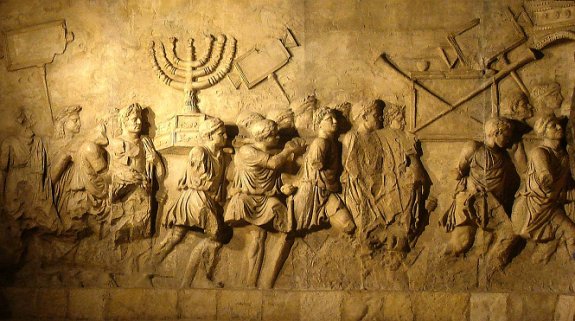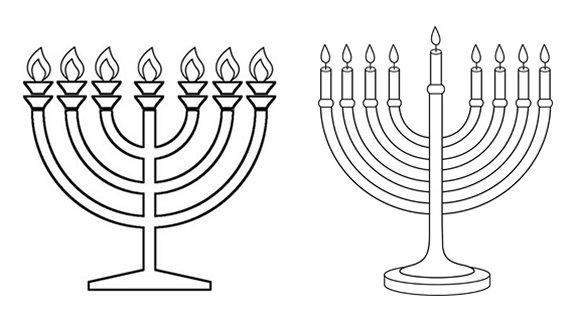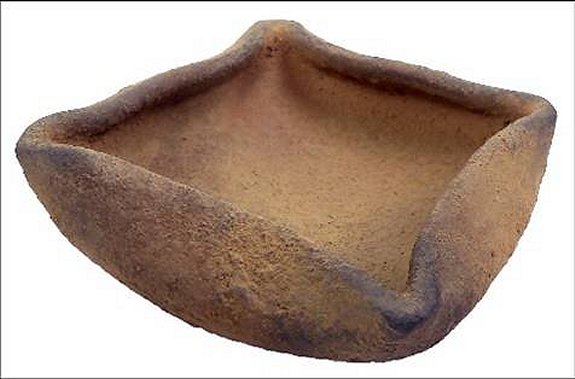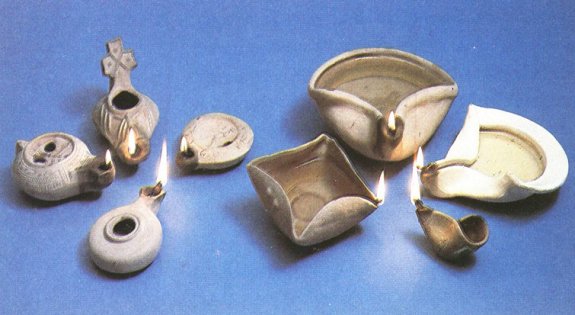Your word is a lamp to my feet and a light to my path (Psalm 119:105)

A hand-made ceramic oil lamp from the Holy Land in Old Testament times. The bowl was filled with olive oil. One end of a flax wick sat in the oil and the other, which hung out over the spout, was lit to provide minimal light in an ancient house. This lamp, dating to the 10th century BC, is the type known to King David and most of the writers of the Psalms. A lamp like this is referred to in Psalm 119:105.
The longest chapter of the Bible (176 verses), Psalm 119 is also an acrostic poem where every eight verses starts with successive letters of the 22-letter Hebrew alphabet. Many Bibles indicate this arrangement by headlining each section with that Hebrew letter (verses 1-8 aleph; verses 9-16 beth; verses 17-24 gimel; 8 verses x 22 letters = 176 verses, etc).
David’s name is associated with 73 of the 150 Psalms, with 50 being anonymous. Of the remaining 27 Psalms, most of the names are understood to be those of priests and Levites serving in the sanctuary during David’s reign.
Psalm 119 is one of the anonymous Psalms. So, while it can’t be said with certainty, it’s reasonable to assume it, too, originated from the circle of those who wrote most of the Psalms within the time of David or, at least, his son Solomon (to whom two Psalms – 72 and 127- are attributed).
While the author isn’t clear, the focus of this chapter is. Commonly known as the Word of God Psalm, 171 of its 176 verses reference God’s Word. Using a variety of terms – “law,” “statutes,” “precepts,” “decrees,” “commandments,” “word” – appreciation of God’s Law above all else is the priority here.
Lamps in the Old Testament
The first mention of a lamp in the Old Testament is the one in the Tabernacle. Understood today as a “lampstand” or “candelabra” (Hebrew menorah; Ex 25:31), on it sat 7 “lamps” (Hebrew neroth; Ex 25:37). The lampstand’s accompanying wicks (25:38) and olive oil (25:6) are also referenced as part of the Tabernacle’s furnishings.

The 7-light menorah taken from the Temple in Jerusalem, as depicted on the ceremonial Arch of Titus, southeast of the Forum along the Via Sacra in Rome. This scene, on the south panel inside the arch depicts items sacked from Jerusalem and the Temple by Roman General Titus in 70 AD.
Throughout the rest of the Old Testament, most “lamp” references are to this Tabernacle lampstand and later versions in the Temple. All these lampstands were made of gold and the olive oil was specifically made with a special formula for holy service.

The 7-light lampstand of the Tabernacle and Temple (left) is commonly called the menorah (“lamp”). The 9-light lampstand (right) of the 8-day Hanukkah celebration commemorates the rededication (Hanukkah means “dedication”) of the Temple in Jerusalem by the Maccabees in 165 BC. This annual December celebration is also called the “Festival of Lights” and the 9 lamps represent the 8 days of miraculous light plus the “helper” (shamash) used to light the others. To be kosher, the “helper” light should be offset from the rest.
But there are other Old Testament mentions of “lamps” in relation to everyday life. Three are in Job (18:6; 21:17; 29:3) and, if this is the oldest book of the Bible, they would be the earliest reference to household lamps. While the material from which these lamps were made is not mentioned, clay lamps are ubiquitous in archaeological excavations across the Holy Land – from 2000 BC to New Testament times.
Lamps in Archaeology
The earliest lamps known in archaeology were simply handmade ceramic bowls with nothing to distinguish them from others bowls, except carbon soot spots visible on the rim. They would have been filled with olive oil and had a flax wick extending from the oil to the rim. Such lamps date to the Early Bronze Age (third millennium BC).
By 2000 BC, potters began creating small protrusions (spouts) on the rim to better control the wicks. While a few are known with 7 spouts, and many with 4, most have only a single wick-spout. All were small enough to fit into a person’s open palm.

A 4-spouted clay oil lamp from the early 2nd millennium BC. It was designed to use 4 wicks together. While it seems like a good idea to the author, the concept didn’t really catch on and this type of lamp died out after about 200 years.
So, apparently, the ancients decided that the one-wick oil lamp was sufficient for their daily needs. Not designed for use in travel, when the sun went down, people did too! It was just too dangerous to be outside wondering around in the dark. The possibility of running into a wild animal roaming about, or just falling into or tripping over something made it judicious to just stay home at night.
Consequently, these lamps were strategically placed in the house to provide optimum light. While they may have sat on the floor or on top of a piece of furniture, excavations frequently reveal niches for lamps on interior walls of ancient houses.
The Lesson of the Lamp in Psalm 119:105
Psalm 119:105 is a well-known verse. Like many in this chapter, it’s a prayer (addressed to God) and also focuses on the Bible. This verse particularly relates God’s Word to a “lamp” and a “light” that will guide our steps.

Four different views of a single one-spout clay oil lamp from the Holy Land. From the time of King David, variations of this hand-made lamp style were used in the region for over 1,500 years.
We can all appreciate the metaphor, recognizing that God’s Word gives light to our lives. But I want to suggest that archaeology can help us appreciate this little verse even more.
While ancient lamps were not designed for travel, they would illumine our way at night. Admittedly one wouldn’t be going far, but the average one-wicker lamp would have been sufficient light to carefully move about the family compound.
So Psalm 119:105 offers confidence that God’s Word would illumine my way like one of those lamps. Not unlike how I’ve used my cell phone to get around in the dark, they would have basically provided just enough light to illumine one step at a time.
In order to move around carefully, it would have been slow, but one step at a time was sufficient and these lamps worked appropriately well in that setting. I suppose most people in the first millennium BC could appreciate the analogy between this lamp and God’s Word. In fact, it was probably hard for them to imagine anything else.
The Lesson of the Lamp for the 21st Century
Of course this is not our world. For most of us, the night is ablaze with light and we can go about our business all night long as if it were daytime.
So, as we consider a Psalm 119:105 light or lamp, we might appreciate a searchlight which would expose everything. With nothing left unseen or unknown we would be comfortable to head out in good faith that God is in control! But the lesson of the lamp suggests a lamp which doesn’t give much light, at all. Just enough to go one step at a time.

Three clay oil lamps from the Associates for Biblical Research’s excavation at Khirbet el-Maqatir. By the Greek period in the Holy Land (3rd century BC) the hand-made clay bowl-style lamps were folded over on the top, virtually creating two holes – one for adding the oil and the other for the wick (top left). By New Testament times, these bowl lamps were replaced by mold-made lamps – with top and bottom made in different molds (top right). The one depicted here was the distinctive Herodian-style with the large hole in the center for adding oil and the spout (slightly broken on the end) for the wick. Mold-made Islamic clay oil lamps (center) carried on the same New Testament tradition, but began taking on a more slipper-like form and added a distinctive high handle at the rear. Note also the geometric designs and the distinctive “channel” between the central hole and the wick spout.
And in the 21st century the lamp of choice for many of us would be a laser beam shooting into the darkness for miles. We would want to know what’s out there in the distance. Armed with that understanding, we may be comfortable to step out, believing God can handle the details. But the lesson of the lamp is clear – just one step, one moment at a time.
We may want more, we may think we need more – but one step, one moment at a time is all He promises us…and, really, all we need!
The Lesson of the Lamp and the Serenity Prayer
Fifteen years ago I took the position of Spiritual Life Director at Helping Up Mission (https://www.helpingupmission.org/), a residential Spiritual Recovery Program for men in downtown Baltimore, Maryland. My role focused on teaching biblical principles of a spiritual walk as the source of empowerment for victory over drugs and alcohol.
But I was learning plenty of things, too. One of which was the complete Serenity Prayer. While I already knew the rather famous first section, I had no idea there was more. And, it was the rest of the prayer that really spoke to me.
I remember the first time I read the complete Serenity Prayer, my heart said, “Yes! That’s the guy I really want to be!”
It centered on two lines, “Living One Day at a Time…Enjoying One Moment at a Time.” This whole Prayer described the way I wanted to live and it was the same Lesson I learned from the Lamp.
God, grant me
The SERENITY to accept the things I cannot change,
The COURAGE to change the things I can,
And the WISDOM to know the difference;
LIVING one day at a time;
ENJOYING one moment at a time;
ACCEPTING hardship as a pathway to peace;
TAKING, as Jesus did, this sinful world, as it is, not as I would have it;
TRUSTING that You will make all things right if I surrender to Your will;
So that I may be REASONABLY happy in this life and
SUPREMELY happy with You forever in the next. Amen.
Adapted from Reinhold Niebuhr
(see http://www.helpingupmission.blogspot.com/2013/01/the-serenity-prayer.html)
The Lesson of the Lamp and the Lord’s Prayer
Of course, this also truth goes along with the most famous prayer of all – the Lord’s Prayer or the Our Father. “…Give us this day our daily bread” (Mt 6:11) reminds us of the biblical truth that God only promises us one day at a time.
But Jesus adds some additional light on the subject in the last verse of the chapter. “Therefore do not worry about tomorrow, for tomorrow will worry about itself. Each day has enough trouble of its own” (Mt 6:34).
He only promises one day at a time…He only asks from us one day at a time. Like the Lesson of the Lamp – it’s always been one step, one moment, one day at a time!
So every time another ancient lamp is dug up, it’s just another gentle reminder of His wonderful promise. He’s got everything under control and all I have to do is keep walking…one step, one moment, one day at a time!

Light over the centuries. These ancient lamps represent almost 3,000 years of light in the Holy Land.